HONDA PILOT 2003 1.G Service Manual
Manufacturer: HONDA, Model Year: 2003, Model line: PILOT, Model: HONDA PILOT 2003 1.GPages: 392, PDF Size: 5.06 MB
Page 41 of 392
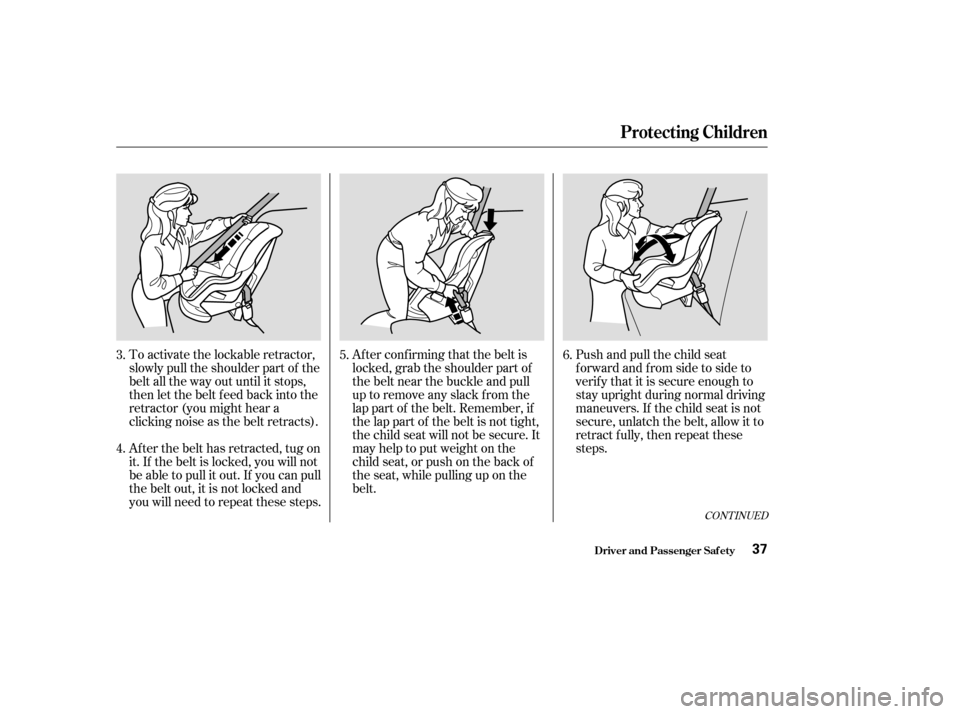
Push and pull the child seat
f orward and f rom side to side to
verif y that it is secure enough to
stay upright during normal driving
maneuvers. If the child seat is not
secure, unlatch the belt, allow it to
retract f ully, then repeat these
steps.
Af ter conf irming that the belt is
locked, grab the shoulder part of
the belt near the buckle and pull
up to remove any slack from the
lap part of the belt. Remember, if
the lap part of the belt is not tight,
the child seat will not be secure. It
mayhelptoputweightonthe
child seat, or push on the back of
the seat, while pulling up on the
belt.
To activate the lockable retractor,
slowly pull the shoulder part of the
belt all the way out until it stops,
then let the belt f eed back into the
retractor (you might hear a
clicking noise as the belt retracts).
Af ter the belt has retracted, tug on
it. If the belt is locked, you will not
be able to pull it out. If you can pull
the belt out, it is not locked and
you will need to repeat these steps.
3.
4.
5.
6.
CONT INUED
Protecting Children
Driver and Passenger Saf ety37
Page 42 of 392

To deactivate the locking
mechanism in order to remove a
child restraint system, unlatch the
buckle, unroute the seat belt, and let
the belt fully retract.When a child reaches the
recommended weight or height limit
for a forward-facing child seat, the
child should sit in the back seat on a
booster and wear a lap/shoulder belt.
We recommend that the child use a
booster seat until the child is tall
enough to use the seat belt without a
booster.
The f ollowing pages give
instructions on how to check proper
seat belt f it, what kind of booster
seat to use if one is needed, and
important precautions f or a child
who must sit in the f ront seat. Protecting L arger Children
Protecting Children
Driver and Passenger Saf ety38
Allowing a larger child to sit
improperly in the front seat can
result in injury or death if the
passenger’s front airbag inflates.
If a larger child must sit in front,
make sure the child moves the
seat as far back as possible,
uses a booster seat if needed,
and wears the seat belt properly.
Page 43 of 392
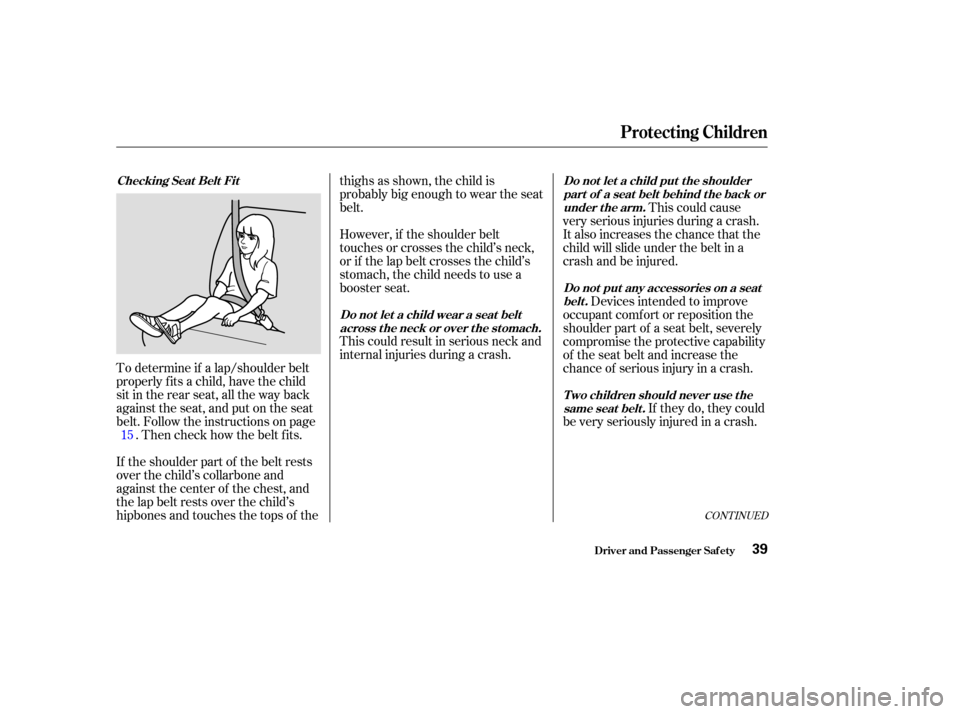
CONT INUED
To determine if a lap/shoulder belt
properly f its a child, have the child
sit in the rear seat, all the way back
against the seat, and put on the seat
belt. Follow the instructions on page. Then check how the belt f its.
If the shoulder part of the belt rests
over the child’s collarbone and
against the center of the chest, and
the lap belt rests over the child’s
hipbones and touches the tops of the thighs as shown, the child is
probably big enough to wear the seat
belt.
However, if the shoulder belt
touchesorcrossesthechild’sneck,
or if the lap belt crosses the child’s
stomach, the child needs to use a
booster seat.
This could result in serious neck and
internal injuries during a crash.
This could cause
very serious injuries during a crash.
It also increases the chance that the
child will slide under the belt in a
crash and be injured.
Devices intended to improve
occupant comf ort or reposition the
shoulder part of a seat belt, severely
compromise the protective capability
of the seat belt and increase the
chance of serious injury in a crash.
If they do, they could
be very seriously injured in a crash.
15
Checking Seat Belt Fit
Do not let a child wear a seat beltacross t he neck or over t he st omach. Do not let a child put the shoulder
part of a seat belt behind t he back orunder t he arm.
Do not put any accessories on a seatbelt.
T wo children should never use t hesame seat belt .
Protecting Children
Driver and Passenger Saf ety39
Page 44 of 392
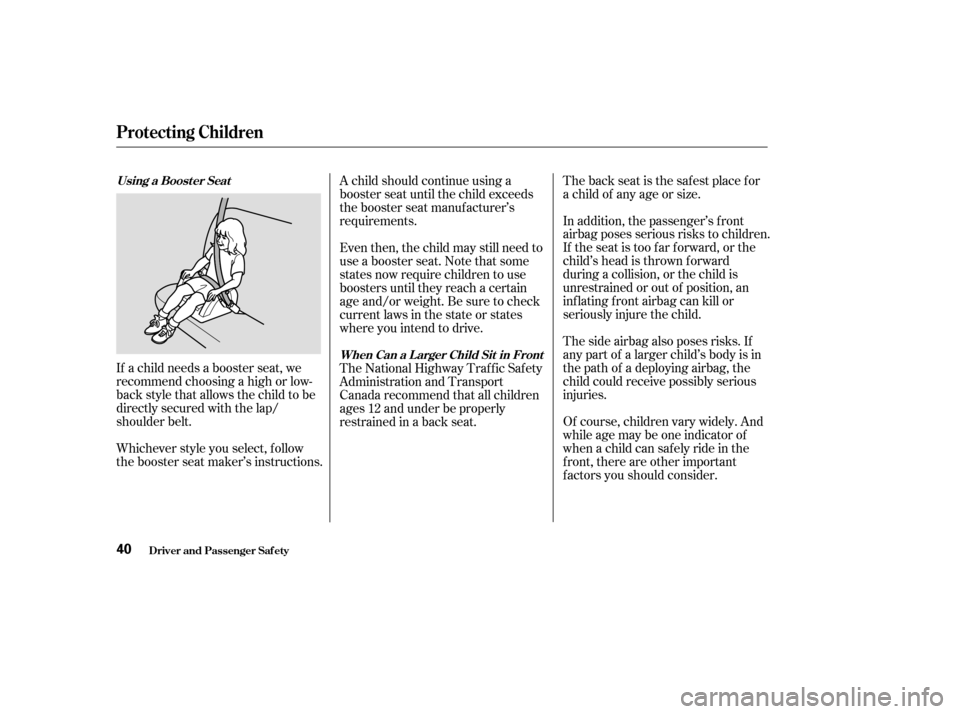
Of course, children vary widely. And
while age may be one indicator of
when a child can saf ely ride in the
f ront, there are other important
f actors you should consider.
Whichever style you select, f ollow
the booster seat maker’s instructions. The back seat is the safest place for
a child of any age or size.
In addition, the passenger’s f ront
airbag poses serious risks to children.
If the seat is too f ar f orward, or the
child’s head is thrown f orward
during a collision, or the child is
unrestrained or out of position, an
inf lating f ront airbag can kill or
seriously injure the child.
The side airbag also poses risks. If
any part of a larger child’s body is in
the path of a deploying airbag, the
child could receive possibly serious
injuries.
If a child needs a booster seat, we
recommend choosing a high or low-
back style that allows the child to be
directly secured with the lap/
shoulder belt. A child should continue using a
booster seat until the child exceeds
the booster seat manufacturer’s
requirements.
Even then, the child may still need to
use a booster seat. Note that some
states now require children to use
boosters until they reach a certain
ageand/orweight.Besuretocheck
current laws in the state or states
where you intend to drive.
The National Highway Traffic Safety
Administration and Transport
Canada recommend that all children
ages 12 and under be properly
restrained in a back seat.
Using a Boost er Seat
When Can a Larger Child Sit in Front
Protecting Children
Driver and Passenger Saf ety40
Page 45 of 392
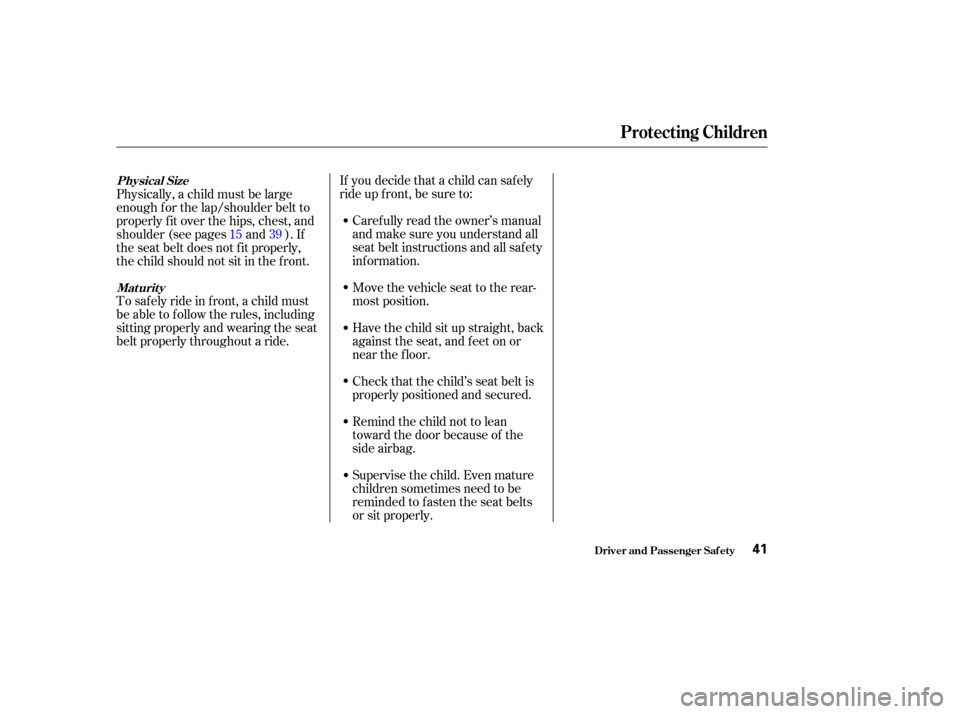
If you decide that a child can saf ely
ride up f ront, be sure to:Caref ully read the owner’s manual
and make sure you understand all
seat belt instructions and all saf ety
inf ormation.
Move the vehicle seat to the rear-
most position.
Have the child sit up straight, back
against the seat, and feet on or
near the f loor.
Check that the child’s seat belt is
properly positioned and secured.
Physically, a child must be large
enough f or the lap/shoulder belt to
properly f it over the hips, chest, and
shoulder (see pages and ). If
the seat belt does not f it properly,
the child should not sit in the f ront.
To saf ely ride in f ront, a child must
be able to f ollow the rules, including
sitting properly and wearing the seat
belt properly throughout a ride.
Supervise the child. Even mature
children sometimes need to be
reminded to f asten the seat belts
or sit properly. Remind the child not to lean
toward the door because of the
side airbag.
15 39Physical Size
Maturity
Protecting Children
Driver and Passenger Saf ety41
Page 46 of 392
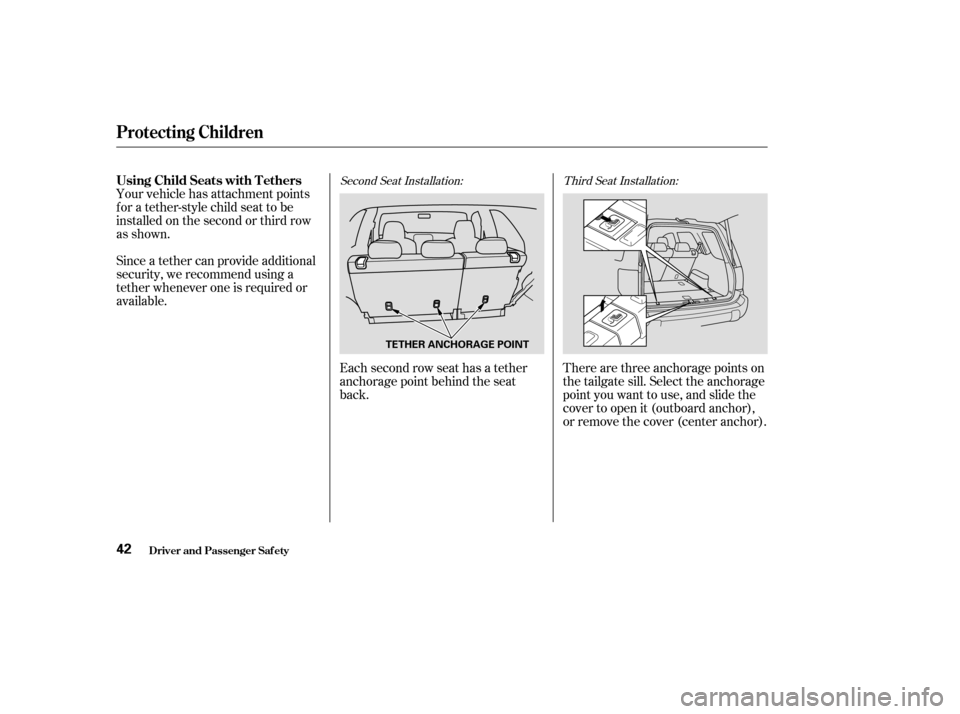
Your vehicle has attachment points
for a tether-style child seat to be
installed on the second or third row
as shown.
Since a tether can provide additional
security, we recommend using a
tether whenever one is required or
available.Each second row seat has a tether
anchorage point behind the seat
back.There are three anchorage points on
the tailgate sill. Select the anchorage
point you want to use, and slide the
cover to open it (outboard anchor),
or remove the cover (center anchor).
Second Seat Installation:
Third Seat Installation:Using Child Seats with T ethers
Protecting Children
Driver and Passenger Saf ety42
TETHER ANCHORAGE POINT
Page 47 of 392
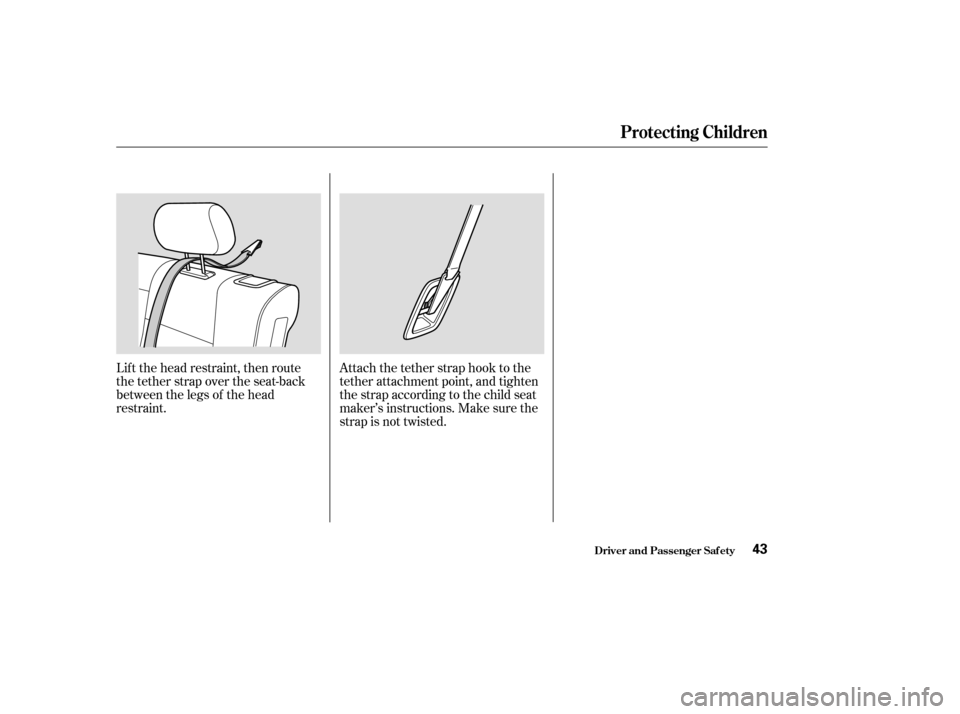
Lift the head restraint, then route
the tether strap over the seat-back
between the legs of the head
restraint.Attach the tether strap hook to the
tether attachment point, and tighten
the strap according to the child seat
maker’s instructions. Make sure the
strap is not twisted.
Protecting Children
Driver and Passenger Saf ety43
Page 48 of 392
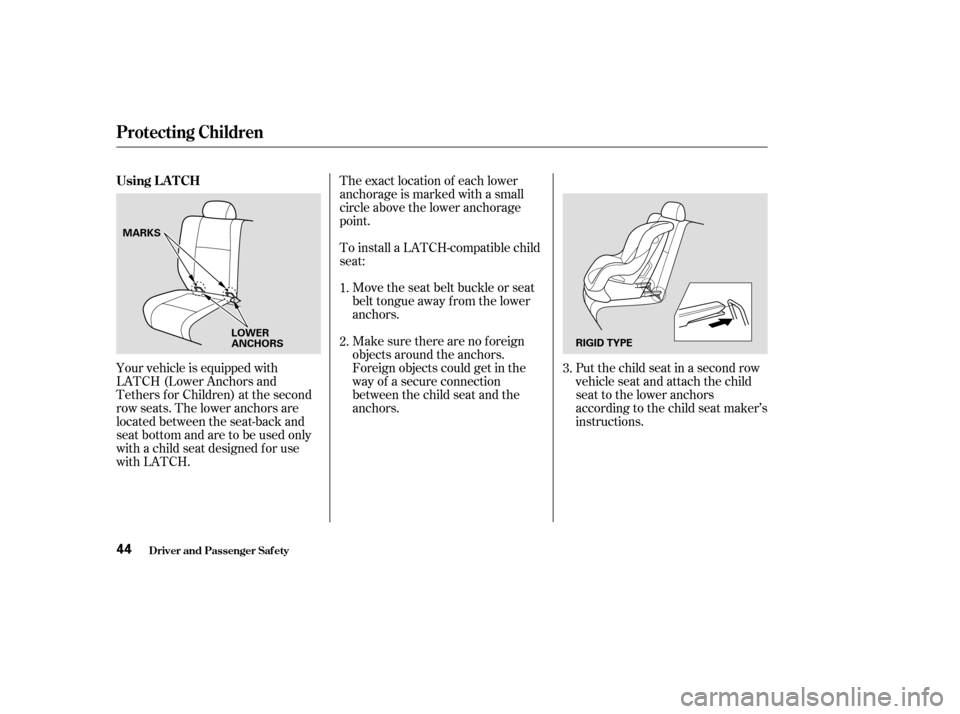
Put the child seat in a second row
vehicle seat and attach the child
seat to the lower anchors
according to the child seat maker’s
instructions.
Your vehicle is equipped with
LATCH (Lower Anchors and
Tethers f or Children) at the second
row seats. The lower anchors are
located between the seat-back and
seat bottom and are to be used only
with a child seat designed f or use
with LATCH. The exact location of each lower
anchorage is marked with a small
circle above the lower anchorage
point.
Move the seat belt buckle or seat
belt tongue away f rom the lower
anchors.
To install a LATCH-compatible child
seat:
Make sure there are no f oreign
objects around the anchors.
Foreign objects could get in the
way of a secure connection
between the child seat and the
anchors.
1.
2.
3.
Using L A T CH
Protecting Children
Driver and Passenger Saf ety44
LOWER
ANCHORS
RIGID TYPE
MARKS
Page 49 of 392

Follow the child seat maker’s
instructions f or any additional
advice on adjusting or tightening
the fit.Attach the attaching clip to the
tether anchor fitting and tighten
the strap according to the child
seat maker’s instructions. Make
sure the strap is not twisted.
Push and pull the child seat
f orward and f rom side to side to
verif y that it is secure enough to
stay upright during normal driving
maneuvers.This symbol on rear or f orward
f acing child seats or booster
cushions indicates the presence of
LATCH compatible hardware.
4.
5.
6.
Protecting Children
Driver and Passenger Saf ety
L ower Universal Anchorage
System Symbol
45
FLEXIBLE TYPE
Page 50 of 392
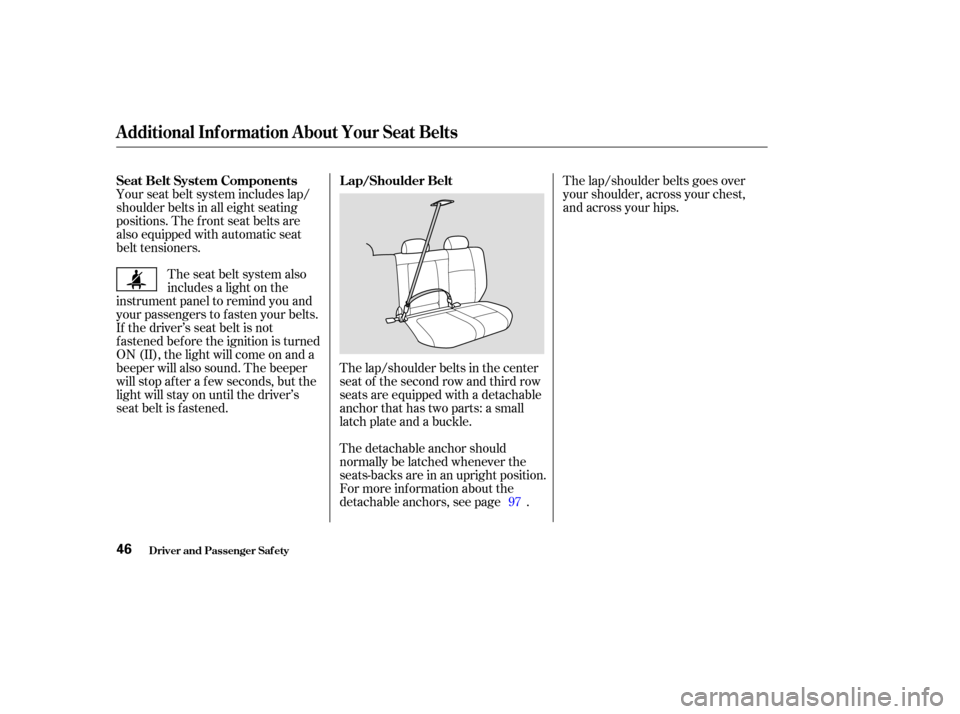
The seat belt system also
includes a light on the
instrument panel to remind you and
your passengers to f asten your belts.
If the driver’s seat belt is not
fastened before the ignition is turned
ON (II), the light will come on and a
beeper will also sound. The beeper
will stop af ter a f ew seconds, but the
light will stay on until the driver’s
seat belt is f astened. The lap/shoulder belts goes over
your shoulder, across your chest,
and across your hips.
Your seat belt system includes lap/
shoulder belts in all eight seating
positions. The f ront seat belts are
also equipped with automatic seat
belt tensioners.
The lap/shoulder belts in the center
seat of the second row and third row
seats are equipped with a detachable
anchor that has two parts: a small
latch plate and a buckle.
The detachable anchor should
normally be latched whenever the
seats-backs are in an upright position.
For more inf ormation about the
detachable anchors, see page .97
Seat Belt System Components L ap/Shoulder Belt
Additional Inf ormation About Your Seat Belts
Driver and Passenger Saf ety46